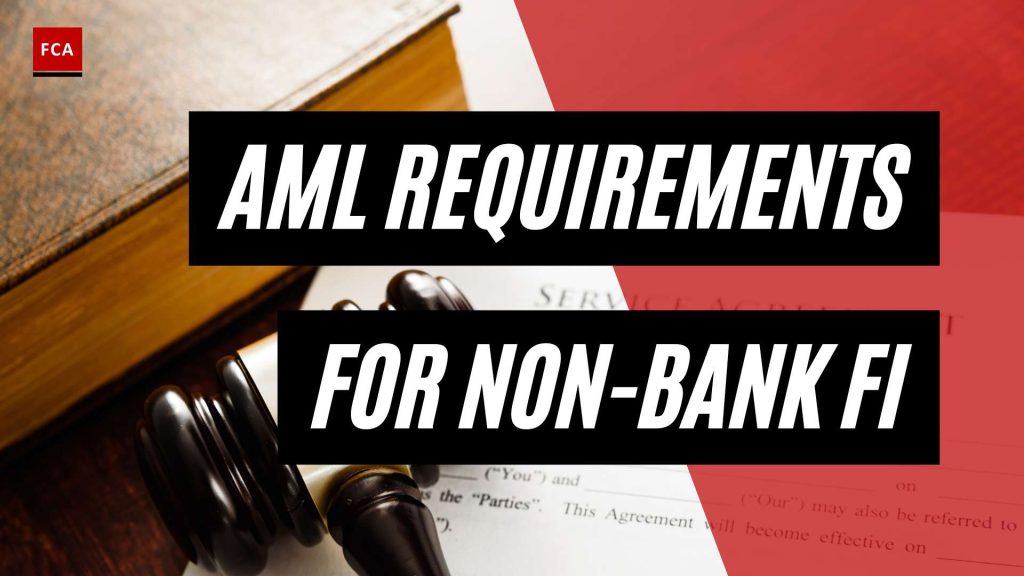Understanding AML Requirements for Non-Bank Financial Institutions
To effectively combat financial crimes such as money laundering and terrorist financing, non-bank financial institutions must adhere to Anti-Money Laundering (AML) requirements. Understanding these requirements and their importance is essential for professionals working in compliance, risk management, anti-money laundering, and anti-financial crime roles.
Introduction to AML for Non-Bank Financial Institutions
AML refers to the set of regulations, laws, and procedures implemented to prevent and detect activities related to money laundering and terrorist financing. Non-bank financial institutions, including insurance companies, money service businesses, securities dealers, and other financial intermediaries, play a crucial role in the global financial system. These institutions are vulnerable to being exploited by criminals seeking to launder illicit funds. Therefore, they are subject to specific AML requirements to ensure compliance and protect against such risks.
The regulatory landscape governing AML for non-bank financial institutions is complex and constantly evolving. Regulators worldwide, driven by the need to combat financial crimes, have established a comprehensive framework of laws and regulations to guide these institutions. By adhering to these requirements, non-bank financial institutions contribute to maintaining the integrity of the financial system.
Importance of AML Compliance for Non-Bank Financial Institutions
Compliance with AML regulations is of paramount importance for non-bank financial institutions. Failure to comply can result in severe consequences, including fines, imprisonment, loss of reputation, and even closure of the business (Financial Crime Academy). The repercussions of non-compliance extend beyond the specific institution, impacting the broader financial system and economy, leading to significant financial losses and instability (Financial Crime Academy).
Regulators are increasingly focusing on enforcing AML regulations for non-bank financial institutions to combat financial crimes. These institutions are at the forefront of the fight against money laundering and terrorist financing. Therefore, implementing effective AML compliance programs is crucial to mitigate the associated risks and ensure regulatory compliance. By doing so, non-bank financial institutions can avoid the severe consequences of non-compliance and contribute to the overall stability of the financial system (Financial Crime Academy).
In the following sections, we will explore the key AML regulations for non-bank financial institutions and delve into the compliance program requirements that these institutions must adhere to. Understanding these aspects is fundamental for professionals in the industry to ensure robust AML controls and procedures within their organizations.
Regulatory Framework for AML Compliance
To ensure the integrity of the financial system and combat money laundering and terrorist financing, non-bank financial institutions (NBFIs) must adhere to a robust regulatory framework. This framework encompasses key anti-money laundering (AML) regulations and establishes compliance program requirements for NBFIs.
Key AML Regulations for Non-Bank Financial Institutions
NBFIs in various jurisdictions are subject to specific AML regulations to address the risks associated with money laundering and terrorist financing. For example, in Canada, financial entities must fulfill obligations under the Proceeds of Crime (Money Laundering) and Terrorist Financing Act (PCMLTFA) and associated regulations (source). These regulations outline the requirements and obligations that NBFIs must meet to ensure compliance.
Other countries may have their own AML regulations tailored to the needs of their financial systems. It is crucial for NBFIs to be aware of and comply with the specific AML regulations applicable to their jurisdiction. This includes understanding customer identification and verification requirements, record-keeping obligations, and reporting suspicious transactions to the relevant authorities.
Compliance Program Requirements for Non-Bank Financial Institutions
To effectively manage AML risks, NBFIs must implement comprehensive compliance programs. These programs are designed to ensure adherence to AML regulations and mitigate the risks of money laundering and terrorist financing.
The compliance program requirements for NBFIs typically include the following elements:
-
Internal Policies and Procedures: NBFIs must establish and maintain internal policies and procedures that address their specific AML risks. These policies and procedures should cover customer due diligence, transaction monitoring, record-keeping, and reporting obligations.
-
Designation of a Compliance Officer: NBFIs are required to designate a qualified individual as the AML compliance officer. This person is responsible for overseeing the institution’s compliance with AML regulations, implementing the compliance program, and reporting any suspicious transactions.
-
Training and Education: NBFIs must provide regular AML training to employees, ensuring they are aware of their obligations and can effectively identify and report suspicious activities. Training programs should cover topics such as customer due diligence, transaction monitoring, and the reporting of suspicious transactions.
-
Ongoing Monitoring and Reporting: NBFIs are required to establish robust systems for ongoing monitoring of customer transactions and activities. This includes implementing appropriate risk-based transaction monitoring processes to detect and report any suspicious or unusual activities.
-
Record-Keeping: NBFIs must maintain accurate records of customer transactions, identification documents, and any suspicious activities. These records should be kept for a specified period as required by the relevant AML regulations.
By implementing effective AML compliance programs, NBFIs can demonstrate their commitment to preventing money laundering and terrorist financing. Compliance with the regulatory framework not only helps protect the financial system but also safeguards NBFIs from the severe consequences of non-compliance, such as penalties, fines, legal repercussions, and reputational damage.
For more information on AML requirements and best practices for NBFIs, consult our article on aml requirements for non-bank financial institutions.
Customer Due Diligence and Verification
When it comes to Anti-Money Laundering (AML) requirements for non-bank financial institutions, customer due diligence (CDD) and identity verification play a crucial role in mitigating the risk of money laundering and terrorist financing. Non-bank financial institutions must adhere to strict guidelines in verifying the identity of their customers and conducting due diligence activities. Let’s explore the specific requirements for identity verification and customer due diligence in this section.
Identity Verification Requirements for Non-Bank Financial Institutions
Non-bank financial institutions are required to verify the identity of individuals and entities for certain activities and transactions, as mandated by AML regulations (Source). These requirements are in place to ensure that financial institutions have accurate and up-to-date information about their customers to prevent fraudulent activities.
Identity verification involves collecting and verifying personal information, such as name, address, date of birth, and identification numbers. Non-bank financial institutions must obtain and confirm the accuracy of beneficial ownership information for entities as well (Source). This process helps to identify the individuals who ultimately own or control the customer entity, ensuring transparency and accountability.
To facilitate identity verification, non-bank financial institutions may use various methods, including government-issued identification documents, utility bills, and other reliable sources of information. Some institutions also leverage technology solutions and databases that provide access to identity verification services to streamline the process and enhance accuracy.
Customer Due Diligence Activities for Non-Bank Financial Institutions
In addition to identity verification, non-bank financial institutions are required to perform customer due diligence (CDD) activities. CDD involves gathering relevant information about the customer’s background and purpose of the relationship to assess potential risks associated with money laundering or terrorist financing.
CDD activities typically include:
-
Risk Assessment: Non-bank financial institutions should conduct a risk assessment to determine the level of risk posed by each customer. This assessment helps institutions identify high-risk customers who require enhanced due diligence measures.
-
Customer Profile: Institutions must establish a customer profile by collecting information such as occupation, source of funds, and expected transactional activity. This information provides a better understanding of the customer’s financial behavior and helps identify any suspicious activities that may require further scrutiny.
-
Ongoing Monitoring: Non-bank financial institutions must continuously monitor customer transactions and activities to detect and report any suspicious behavior. This includes keeping records of transactions, conducting periodic reviews of customer information, and implementing systems to identify and report unusual transactions.
By implementing robust identity verification processes and conducting thorough customer due diligence activities, non-bank financial institutions can strengthen their AML compliance efforts and contribute to the overall integrity of the financial system.
To learn more about AML requirements for non-bank financial institutions, refer to our articles on AML compliance for non-bank financial institutions, AML regulations for non-bank financial institutions, and AML controls for non-bank financial institutions.
Ongoing Monitoring and Reporting
Once non-bank financial institutions (NBFIs) have implemented their Anti-Money Laundering (AML) compliance programs, they must ensure ongoing monitoring and reporting to effectively combat money laundering and illicit activities. Ongoing monitoring helps detect suspicious transactions, while reporting obligations ensure that relevant authorities are informed about potential risks and concerns.
Monitoring Requirements for Non-Bank Financial Institutions
NBFIs have an ongoing responsibility to monitor their clients’ financial activities. This monitoring is especially crucial for clients with whom they have entered into a business relationship. By continuously monitoring transactions and account activities, NBFIs can identify any unusual patterns or transactions that may indicate potential money laundering or other illicit activities. These monitoring requirements help NBFIs fulfill their regulatory obligations and mitigate the risks associated with financial crimes.
Monitoring processes typically involve the use of advanced technologies and AML software solutions. These tools enable NBFIs to analyze large volumes of data and identify suspicious activities more efficiently. By setting up automated alerts and transaction monitoring systems, NBFIs can flag transactions that meet predetermined criteria, such as large or frequent cash transactions, transactions involving high-risk jurisdictions, or transactions inconsistent with a client’s known profile.
To effectively meet monitoring requirements, NBFIs should establish comprehensive AML controls, policies, and procedures. These should include clear guidelines for identifying and reporting suspicious activities, as well as training programs to ensure that employees understand their responsibilities in detecting and reporting potential money laundering activities. For further guidance on establishing effective AML programs, refer to our article on AML program for non-bank financial institutions.
Reporting Obligations for Non-Bank Financial Institutions
NBFIs have reporting obligations to relevant authorities, which vary depending on the jurisdiction and regulatory requirements. Reporting suspicious transactions and activities is a critical part of AML compliance. By promptly reporting such activities, NBFIs contribute to the overall efforts in combating money laundering and terrorist financing.
Reporting obligations typically involve filing Suspicious Activity Reports (SARs) or Suspicious Transaction Reports (STRs) with the appropriate regulatory bodies. These reports provide detailed information about the suspicious activities observed during monitoring. The reports should include relevant transaction details, customer information, and any supporting evidence or documentation.
It is essential for NBFIs to have a clear understanding of the reporting requirements specific to their jurisdiction. This includes knowing the threshold criteria for reporting, the designated reporting channels, and the specific timelines for submitting reports. By adhering to these obligations, NBFIs demonstrate their commitment to AML compliance and contribute to the integrity of the financial system.
To effectively fulfill reporting obligations, NBFIs must establish robust internal processes and procedures. This includes designating responsible individuals or teams for handling and submitting reports, ensuring timely communication, and maintaining appropriate records for auditing and regulatory purposes. Training employees on reporting requirements and providing them with clear guidance will help streamline the reporting process.
By diligently monitoring transactions and fulfilling reporting obligations, NBFIs play a crucial role in mitigating the risks associated with money laundering and financial crimes. It is essential for NBFIs to stay up to date with the evolving regulatory landscape and adapt their monitoring and reporting processes accordingly. Collaborative efforts within the industry, such as sharing best practices and leveraging technology, can further enhance the effectiveness of AML compliance in the non-bank financial sector. For more information on collaborative efforts, refer to our article on international cooperation in combating money laundering and the role of technology in anti-money laundering efforts.
Consequences of Non-Compliance with AML Requirements
Non-compliance with Anti-Money Laundering (AML) requirements for non-bank financial institutions can have severe consequences. It is essential for these institutions to understand the potential penalties and fines they may face, as well as the reputational and legal consequences that can arise from non-compliance.
Penalties and Fines for Non-Bank Financial Institutions
Regulators are increasingly focusing on the enforcement of AML regulations for non-bank financial institutions to combat financial crimes like money laundering and terrorist financing. As a result, the penalties and fines for non-compliance have become more stringent. Financial institutions that fail to meet their AML obligations may face hefty fines imposed by regulatory authorities. These fines can range from substantial monetary amounts to a percentage of the institution’s annual turnover.
The exact penalties and fines vary by jurisdiction, but they are designed to be proportionate to the severity of the non-compliance. In some cases, individuals responsible for the non-compliance may also face personal fines or even imprisonment. It is crucial for non-bank financial institutions to understand and adhere to the specific AML regulations applicable to their jurisdiction to avoid these potential penalties.
Reputational and Legal Consequences of Non-Compliance
Beyond financial penalties, non-compliance with AML requirements can have significant reputational and legal consequences. Financial institutions that are found to be non-compliant may suffer damage to their reputation and loss of public trust. This can result in a loss of customers, business opportunities, and partnerships.
The reputational damage may extend beyond the specific institution, impacting the broader financial system and economy. Non-compliance can create systemic risks, leading to financial losses and instability. To avoid these consequences, non-bank financial institutions must prioritize AML compliance to protect their reputation and the integrity of the financial system.
In addition to reputational risks, non-compliance with AML requirements may also result in legal consequences. Regulatory authorities have the power to take legal action against non-compliant institutions, which can lead to lengthy investigations, legal proceedings, and court-imposed sanctions. These legal consequences can further damage the institution’s reputation and result in additional financial burdens.
To mitigate the risks associated with non-compliance, non-bank financial institutions must prioritize the implementation of effective AML compliance programs. These programs should include robust policies, procedures, controls, and training to ensure regulatory compliance and prevent the severe consequences of non-compliance. By actively addressing money laundering and terrorist financing risks, these institutions can enhance their AML compliance capabilities and navigate the evolving regulatory landscape with confidence.
For more information on AML compliance for non-bank financial institutions, please visit our article on AML compliance for non-bank financial institutions.
Best Practices for AML Compliance in Non-Bank Financial Institutions
To ensure compliance with Anti-Money Laundering (AML) requirements, non-bank financial institutions (NBFIs) must implement effective AML compliance programs and leverage technology to enhance their AML efforts.
Implementing Effective AML Compliance Programs
Developing and implementing an effective AML compliance program is essential for NBFIs to meet regulatory obligations and mitigate the risk of money laundering and terrorist financing. The program should be tailored to the specific needs and risks of the institution, taking into account the nature of its business activities and customer base.
Key components of an effective AML compliance program for NBFIs include:
-
Policies and Procedures: Establish comprehensive AML policies and procedures that outline the institution’s commitment to AML compliance and provide guidance on key processes, such as customer due diligence, transaction monitoring, and reporting. These policies and procedures should be regularly reviewed and updated to reflect changes in regulations and industry best practices.
-
Risk Assessment: Conduct a thorough risk assessment to identify and evaluate the money laundering and terrorist financing risks specific to the institution. This assessment should consider factors such as the types of services offered, customer base, geographic locations, and the institution’s exposure to high-risk jurisdictions or industries. The findings of the risk assessment should inform the design and implementation of risk-based controls.
-
Customer Due Diligence (CDD): Implement robust CDD procedures to verify the identity of customers, assess their risk profile, and monitor their transactions. This includes conducting enhanced due diligence for high-risk customers and applying ongoing monitoring to detect and report suspicious activity. Refer to our section on Identity Verification Requirements for Non-Bank Financial Institutions for more details.
-
Employee Training: Provide regular and comprehensive AML training to employees at all levels of the organization. Training should cover the institution’s AML policies and procedures, regulatory requirements, red flags of suspicious activity, and reporting obligations. By ensuring employees are knowledgeable and aware of their responsibilities, NBFIs can create a culture of compliance throughout the organization.
-
Independent Testing and Auditing: Conduct independent testing and auditing of the AML compliance program to assess its effectiveness and identify any gaps or weaknesses. This can be done through internal audits or by engaging external experts to perform independent reviews. Regular testing and auditing help ensure ongoing compliance and provide an opportunity to enhance the program based on identified areas for improvement.
Leveraging Technology for AML Compliance
NBFIs can enhance their AML compliance efforts by leveraging technology solutions tailored to their specific needs. Advanced technologies can streamline and automate various AML processes, improving efficiency and effectiveness. Here are some ways technology can support AML compliance in NBFIs:
-
Transaction Monitoring Systems: Implement robust transaction monitoring systems that can analyze large volumes of data in real-time to detect unusual patterns or suspicious activities. These systems can generate alerts for further investigation, helping NBFIs identify and report potentially illicit transactions. Regularly review and update the monitoring rules to align with emerging risks and regulatory changes.
-
Data Analytics: Utilize data analytics tools to analyze and visualize large datasets, enabling NBFIs to identify trends, anomalies, and potential risks. By leveraging data analytics, NBFIs can gain valuable insights into customer behavior, enhance risk assessments, and improve the effectiveness of AML controls.
-
Know Your Customer (KYC) Solutions: Implement KYC solutions that automate the customer onboarding process, including identity verification, screening against sanctions lists and politically exposed persons (PEPs), and risk profiling. These solutions can streamline the CDD process, enhance accuracy, and reduce manual errors.
-
Case Management Systems: Utilize case management systems to facilitate the investigation and management of suspicious activity reports (SARs) and other compliance-related cases. These systems help ensure that investigations are conducted thoroughly, documented appropriately, and reported to the relevant authorities within the required timeframes.
By embracing technology, NBFIs can improve their AML compliance capabilities, enhance operational efficiencies, and better identify and mitigate money laundering and terrorist financing risks.
Implementing effective AML compliance programs and leveraging technology are critical steps for NBFIs to meet regulatory requirements, protect their institutions from financial crime, and maintain the integrity of the financial system. By adopting best practices, NBFIs can establish a robust AML framework that promotes compliance, mitigates risks, and builds trust with regulators and stakeholders.
Collaborative Efforts in AML Compliance
In the fight against money laundering, collaborative efforts play a crucial role in combating illicit financial activities. Non-bank financial institutions are actively engaged in international cooperation and leverage technology to enhance their anti-money laundering (AML) efforts.
International Cooperation in Combating Money Laundering
Combating money laundering is beyond the capacity of any single nation. Recognizing this, countries worldwide are increasingly collaborating to tackle this issue together. For example, the International Monetary Fund (IMF) has partnered with eight Nordic and Baltic countries, including Denmark, Estonia, Finland, Iceland, Latvia, Lithuania, Norway, and Sweden, in a first-of-its-kind anti-money laundering technical assistance project. This collaboration aims to enhance the understanding of unusual financial flows, identify emerging threats, and connect cross-border money laundering and terrorism financing risks (IMF Blog).
By sharing information, intelligence, and best practices, countries can strengthen their AML frameworks and improve their ability to detect and prevent money laundering. International cooperation facilitates the identification of global trends, the exchange of suspicious transaction reports, and the tracking of illicit funds across borders. Through these collaborative efforts, non-bank financial institutions can stay ahead of evolving money laundering techniques and effectively mitigate risks.
The Role of Technology in Anti-Money Laundering Efforts
Technology plays a vital role in bolstering AML efforts for non-bank financial institutions. Machine learning technologies and data analysis are increasingly employed by regulatory bodies and financial institutions to scrutinize financial movements and detect indicators of potential money laundering scenarios. The International Monetary Fund (IMF) utilizes these technologies to analyze data related to regional money laundering cases, identify unusual financial flows, and assess macro-critical money laundering risks in member economies. These analyses contribute to the annual health checks of member economies and the Financial Sector Assessment Program (IMF Blog).
The use of technology enables non-bank financial institutions to automate transaction monitoring processes, identify patterns, and flag suspicious activities more efficiently. Advanced analytics and artificial intelligence algorithms can analyze vast amounts of data, identify anomalies, and generate alerts for further investigation. By leveraging technology, these institutions can enhance their ability to detect and prevent money laundering, reducing the risk of financial crimes.
Furthermore, the emergence of new financial technologies, such as cryptocurrencies, has prompted regulators to adopt risk-adjusted scrutiny. Regulators emphasize the need for cross-border cooperation and data exchange to effectively mitigate money laundering risks associated with newer entrants to international finance, such as crypto asset service providers (IMF Blog). Collaboration between regulatory bodies and non-bank financial institutions is essential to stay up to date with emerging threats and develop effective strategies to combat money laundering in the evolving financial landscape.
By actively participating in international cooperation efforts and leveraging technology, non-bank financial institutions can enhance their AML compliance measures. These collaborative approaches enable them to better identify and address money laundering risks, protect the integrity of their operations, and contribute to the global fight against illicit financial activities.








